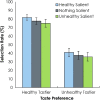Perceptual salience influences food choices independently of health and taste preferences
- PMID: 31900744
- PMCID: PMC6942074
- DOI: 10.1186/s41235-019-0203-2
Perceptual salience influences food choices independently of health and taste preferences
Abstract
Background: Making decisions about food is a critical part of everyday life and a principal concern for a number of public health issues. Yet, the mechanisms involved in how people decide what to eat are not yet fully understood. Here, we examined the role of visual attention in healthy eating intentions and choices. We conducted two-alternative forced choice tests of competing food stimuli that paired healthy and unhealthy foods that varied in taste preference. We manipulated their perceptual salience such that, in some cases, one food item was more perceptually salient than the other. In addition, we manipulated the cognitive load and time pressure to test the generalizability of the salience effect.
Results: Manipulating salience had a powerful effect on choice in all situations; even when an unhealthy but tastier food was presented as an alternative, healthy food options were selected more often when they were perceptually salient. Moreover, in a second experiment, food choices on one trial impacted food choices on subsequent trials; when a participant chose the healthy option, they were more likely to choose a healthy option again on the next trial. Furthermore, robust effects of salience on food choice were observed across situations of high cognitive load and time pressure.
Conclusions: These results have implications both for understanding the mechanisms of food-related decision-making and for implementing interventions that might make it easier for people to make healthy eating choices.
Keywords: Attention; Health; Taste preference; Visual salience.
Conflict of interest statement
The authors declare that they have no competing interests.
Figures




Similar articles
-
A value accumulation account of unhealthy food choices: testing the influence of outcome salience under varying time constraints.Cogn Res Princ Implic. 2023 Jan 12;8(1):4. doi: 10.1186/s41235-022-00459-6. Cogn Res Princ Implic. 2023. PMID: 36633704 Free PMC article.
-
Does my brain want what my eyes like? - How food liking and choice influence spatio-temporal brain dynamics of food viewing.Brain Cogn. 2016 Dec;110:64-73. doi: 10.1016/j.bandc.2015.10.005. Epub 2015 Nov 11. Brain Cogn. 2016. PMID: 26578256
-
Goal-directed visual attention drives health goal priming: An eye-tracking experiment.Health Psychol. 2017 Jan;36(1):82-90. doi: 10.1037/hea0000410. Epub 2016 Sep 15. Health Psychol. 2017. PMID: 27631308
-
Effect of ambience on food intake and food choice.Nutrition. 2004 Sep;20(9):821-38. doi: 10.1016/j.nut.2004.05.012. Nutrition. 2004. PMID: 15325695 Review.
-
Impact of Perceived Healthiness of Food on Food Choices and Intake.Curr Obes Rep. 2016 Mar;5(1):65-71. doi: 10.1007/s13679-016-0192-0. Curr Obes Rep. 2016. PMID: 26820622 Review.
Cited by
-
Contextual and Individual Variables as Predictors of Energy-Dense Meals in Food Choices.Front Psychol. 2022 Jul 6;13:803326. doi: 10.3389/fpsyg.2022.803326. eCollection 2022. Front Psychol. 2022. PMID: 35874367 Free PMC article.
-
Implicit food odour priming effects on reactivity and inhibitory control towards foods.PLoS One. 2020 Jun 9;15(6):e0228830. doi: 10.1371/journal.pone.0228830. eCollection 2020. PLoS One. 2020. PMID: 32516338 Free PMC article.
-
Hedonic response sensitivity to variations in the evaluation task and culinary preparation in a natural consumption context.Front Nutr. 2022 Oct 28;9:1008577. doi: 10.3389/fnut.2022.1008577. eCollection 2022. Front Nutr. 2022. PMID: 36386947 Free PMC article.
-
Digital Nudging for Online Food Choices.Front Psychol. 2021 Dec 20;12:729589. doi: 10.3389/fpsyg.2021.729589. eCollection 2021. Front Psychol. 2021. PMID: 34987443 Free PMC article.
-
Three minutes to change preferences: perceptual fluency and response inhibition.R Soc Open Sci. 2020 Oct 7;7(10):200766. doi: 10.1098/rsos.200766. eCollection 2020 Oct. R Soc Open Sci. 2020. PMID: 33204454 Free PMC article.
References
-
- Armel KC, Beaumel A, Rangel A. Biasing simple choices by manipulating relative visual attention. Judgment and Decision making. 2008;3(5):396–403.
MeSH terms
LinkOut - more resources
Full Text Sources
